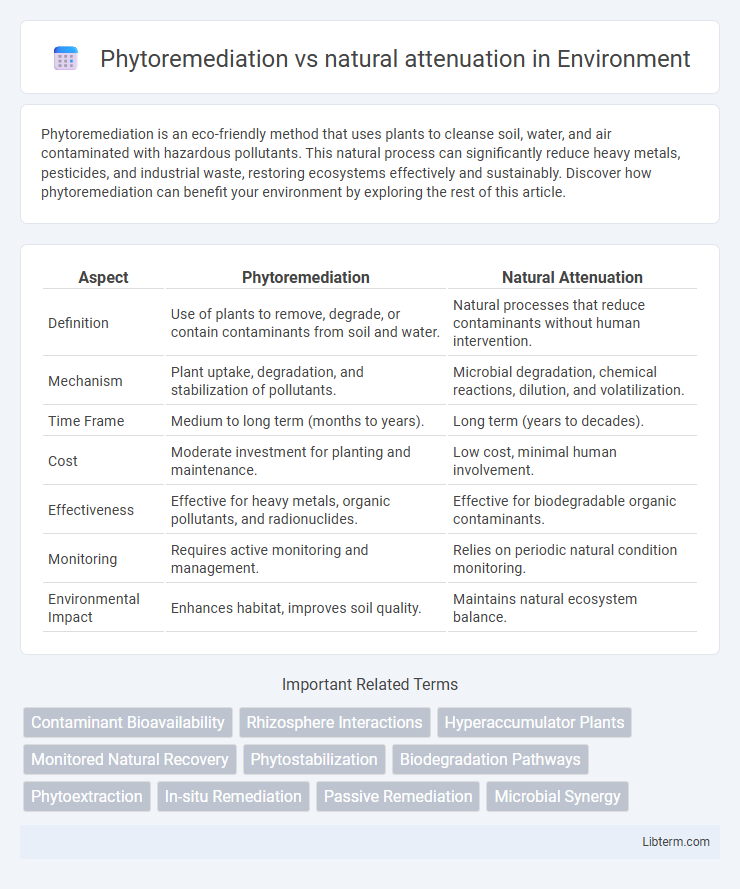Phytoremediation is an eco-friendly method that uses plants to cleanse soil, water, and air contaminated with hazardous pollutants. This natural process can significantly reduce heavy metals, pesticides, and industrial waste, restoring ecosystems effectively and sustainably. Discover how phytoremediation can benefit your environment by exploring the rest of this article.
Table of Comparison
| Aspect | Phytoremediation | Natural Attenuation |
|---|---|---|
| Definition | Use of plants to remove, degrade, or contain contaminants from soil and water. | Natural processes that reduce contaminants without human intervention. |
| Mechanism | Plant uptake, degradation, and stabilization of pollutants. | Microbial degradation, chemical reactions, dilution, and volatilization. |
| Time Frame | Medium to long term (months to years). | Long term (years to decades). |
| Cost | Moderate investment for planting and maintenance. | Low cost, minimal human involvement. |
| Effectiveness | Effective for heavy metals, organic pollutants, and radionuclides. | Effective for biodegradable organic contaminants. |
| Monitoring | Requires active monitoring and management. | Relies on periodic natural condition monitoring. |
| Environmental Impact | Enhances habitat, improves soil quality. | Maintains natural ecosystem balance. |
Introduction to Phytoremediation and Natural Attenuation
Phytoremediation leverages specific plants to remove, stabilize, or degrade contaminants in soil and water through mechanisms like phytoextraction, phytodegradation, and rhizofiltration. Natural attenuation relies on indigenous microbial processes and environmental factors such as biodegradation, dispersion, and sorption to reduce pollutant concentrations without human intervention. Both methods serve as sustainable, cost-effective strategies in environmental remediation, but phytoremediation actively enhances contaminant reduction using vegetation, whereas natural attenuation depends on passive, in-situ processes.
Defining Phytoremediation: Principles and Processes
Phytoremediation employs plants to remediate contaminated sites by extracting, degrading, or immobilizing pollutants through processes such as phytoextraction, phytodegradation, phytostabilization, and rhizodegradation. This technique harnesses natural plant metabolic pathways and root zone interactions to transform hazardous substances into less toxic forms or sequester contaminants in plant biomass. Unlike natural attenuation, which relies solely on passive environmental processes like microbial degradation and chemical stabilization, phytoremediation actively accelerates contaminant removal using specialized plant species adapted to pollutant uptake and breakdown.
Understanding Natural Attenuation Mechanisms
Natural attenuation involves biological, chemical, and physical processes that naturally reduce contaminant concentrations in soil and groundwater without human intervention. Key mechanisms include biodegradation by indigenous microorganisms, chemical precipitation, sorption onto soil particles, and volatilization into the atmosphere. Understanding these processes allows for accurate assessment of contaminant fate and informs decisions on whether active remediation like phytoremediation is necessary.
Key Differences Between Phytoremediation and Natural Attenuation
Phytoremediation uses plants to actively extract, degrade, or stabilize contaminants from soil and water, whereas natural attenuation relies on indigenous microbial processes and environmental conditions to reduce pollutant concentrations over time. Phytoremediation is often faster and can target specific contaminants, while natural attenuation is a passive approach requiring long-term monitoring without intervention. The effectiveness of phytoremediation depends on plant species and contaminant types, contrasting with natural attenuation's dependence on site-specific biogeochemical factors.
Types of Contaminants Addressed by Each Approach
Phytoremediation effectively targets organic contaminants, heavy metals, and radionuclides by using plants to absorb, degrade, or stabilize pollutants in soil and water. Natural attenuation primarily addresses hydrocarbons, solvents, and certain inorganic compounds through naturally occurring microbial degradation and chemical processes without human intervention. While phytoremediation extends remediation capacity to metal-contaminated sites, natural attenuation is limited to contaminants that are biodegradable or chemically transformed in situ.
Environmental Conditions Affecting Effectiveness
Phytoremediation effectiveness depends heavily on environmental factors such as soil pH, temperature, moisture content, and availability of specific contaminants, which influence plant growth and pollutant uptake. Natural attenuation relies on intrinsic biological, chemical, and physical processes influenced by factors like microbial population, redox potential, and nutrient levels present in the environment. Both methods require careful assessment of site-specific conditions to optimize degradation rates and maximize pollutant removal efficiency.
Advantages and Limitations of Phytoremediation
Phytoremediation offers eco-friendly and cost-effective remediation by using plants to absorb, degrade, or stabilize contaminants in soil and water, making it suitable for large-scale and in situ applications. Its ability to improve soil structure and reduce erosion enhances environmental restoration, but limitations include slow treatment times, depth restrictions tied to root systems, and ineffectiveness against contaminants not bioavailable to plants. Unlike natural attenuation, which relies on natural processes without human intervention, phytoremediation actively accelerates contaminant removal but requires careful plant selection and management to optimize outcomes.
Strengths and Challenges of Natural Attenuation
Natural attenuation leverages inherent microbial, chemical, and physical processes to reduce contaminants, offering cost-effective and non-intrusive site remediation with minimal environmental disturbance. Its strengths include seamless integration into ecosystems and the capacity to handle complex contaminant mixtures without extensive technical intervention. Challenges involve prolonged remediation timelines, limited control over contaminant breakdown rates, and difficulties in monitoring and verifying contaminant reductions in heterogeneous subsurface environments.
Case Studies: Real-world Application Comparisons
Phytoremediation demonstrates accelerated contaminant reduction in heavy metal and hydrocarbon sites, as shown in the Penang industrial zone study, compared to slower, passive natural attenuation observed in rural groundwater contamination cases. Real-world applications reveal phytoremediation's effectiveness in bioaccumulation and pollutant degradation, evident in the Chernobyl exclusion zone, whereas natural attenuation relies on indigenous microbial activity with inconsistent timelines. Comparative analyses highlight phytoremediation's targeted intervention benefits for urban and industrial pollution, contrasting with natural attenuation's suitability for low-risk, stable environments.
Choosing the Right Remediation Method for Site Cleanup
Phytoremediation leverages specific plants to extract, degrade, or stabilize contaminants, making it effective for sites with moderate pollution and shallow soil or groundwater contamination. Natural attenuation relies on the inherent microbial, chemical, and physical processes to reduce contaminant concentrations without intervention, suitable for sites with low contamination levels and extended timelines. Selecting the appropriate method depends on site characteristics, contaminant type, cleanup goals, and time constraints, where phytoremediation offers targeted treatment and natural attenuation supports passive, cost-effective remediation.
Phytoremediation Infographic

 libterm.com
libterm.com